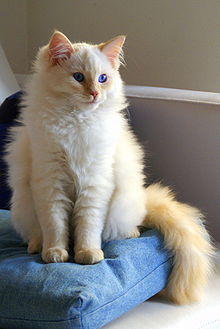- Ragdoll
-
This article is about the cat breed. For other uses, see Rag doll (disambiguation).
Ragdoll 
Origin United States Breed standard FIFe standard CFA standard TICA standard AACE standard ACFA standard ACF standard CCA standard Cat (Felis catus) The Ragdoll is a cat breed with blue eyes and a distinct colorpoint coat. It is a large and muscular semi-longhair cat with a soft and silky coat.[1] Developed by American breeder Ann Baker, it is best known for its docile and placid temperament and affectionate nature. The name "Ragdoll" is derived from the tendency of individuals from the original breeding stock to go limp and relaxed when picked up.
Contents
History
In the 1960s Ann Baker started with a regular non-pedigreed white domestic longhaired Angora-kind cat named Josephine, who had produced several litters of typical cats. This cat was injured in an accident involving a car and taken to the veterinary hospital at the University of California. Josephine was of a Persian/Angora type and had litters sired by several unknown male Birman cats, one of which had the Siamese point coloration. Baker believed that Josephine was subject to a secret government genetic experiment during treatment at the lab, and claimed that it made Josephine docile, relaxed when picked up, and immune to pain. Another claim from her was that the kittens were so relaxed because their mother had a car accident while she was pregnant. (None of these claims have been found to have any basis in fact whatsoever.) After Josephine recovered, she produced kittens with an easygoing temperament. When the subsequent litter produced more of the same, Ann Baker purchased several kittens from the owner, who lived behind her, and believing she had something special, set out to create what is now known as the Ragdoll. The breed was selectively bred over many years for desirable traits, such as large size, gentle demeanor, and a tendency to go limp when picked up, as well as the striking pointed coloration.[2]
Out of those early litters came Blackie, an all black Burmese-like male and Daddy Warbucks, a seal point with white feet. Daddy Warbucks sired the founding bi-color female Fugianna, and Blackie sired Buckwheat, a dark brown/black Burmese-like female. Both Fugianna and Buckwheat were daughters of Josephine. All Ragdolls are descended from Baker's cats through matings of Daddy Warbucks to Fugianna and Buckwheat.
Baker, in an unusual move, spurned traditional cat breeding associations. She trademarked the name "Ragdoll," set up her own registry—International Ragdoll Cat Association (IRCA)—and enforced stringent standards on anyone who wanted to breed or sell cats under that name.[2] The Ragdolls were also not allowed to be registered in other breed associations. In 1975, a group led by Denny Dayton broke rank with IRCA with the aim of gaining mainstream recognition for the Ragdoll. This group eventually developed the Ragdoll standard currently accepted by major cat registries.
Since the spread of the Ragdoll breed in America during the early 1960s, a breeding pair of Ragdolls was exported to the UK. This was followed by eight more cats to fully establish the breed in the UK, where it is recognised by the Governing Council of the Cat Fancy[3]
In 1994, a second group decided to leave the IRCA and form their own group due to increasingly strict breeding restrictions. This group later established the Ragamuffin breed. Because Baker owned the rights to the name "Ragdoll", no offshoot groups could call their cats Ragdolls until the trademark on "Ragdoll" was not renewed in 2005.[4]
Breed description
Temperament
The docile and floppy nature of the Ragdoll is a characteristic thought to be passed down from the Persian and Siamese breed. There are contrary statements on whether this trait might be the result of genetic mutation.[5][6] The extreme docility of some individuals has led to the myth that Ragdolls are pain-resistant. Some breeders in Britain have tried to breed away from the limpness due to concerns that extreme docility "might not be in the best interests of the cat".[5][7] There have been multiple reports of ragdolls nonchalantly approaching moving cars and vicious dogs and getting hurt. Breed standards describe the Ragdoll as affectionate, intelligent, relaxed in temperament, gentle and easy to handle.[8][9]
Physical characteristics
The Ragdoll is one of the largest domesticated cat breeds with a sturdy body, large frame and proportionate legs. A fully-grown female weighs from 8 pounds (3.6 kg) to 15 pounds (6.8 kg). Males are substantially larger, ranging from 12 pounds (5.4 kg) to 20 pounds (9.1 kg)[2] or more. The genes for point coloration are also responsible for the blue eyes of the Ragdoll. More intense shades of blue are favored in the cat shows. Though the breed has a plush coat, it consists mainly of long guard hairs, while the lack of a dense undercoat results in, according to the Cat Fanciers' Association, "reduced shedding and matting".[10] Mitted Ragdolls, which weren't allowed titling until the '08-'09 show season, will often be confused for Birmans. The easiest way to tell the difference is by size (the Ragdoll being obviously larger) and chin color (Ragdolls have white chins, while Birmans have colored chins), although breeders recognize the two by head shape and boning.
References
- ^ Ragdoll Standard FIFe
- ^ a b c Ragdoll J. Anne Helgren (2006). Telemark Productions.
- ^ "Welcome to the Governing Council of the Cat Fancy". http://www.gccfcats.org/breeds.html. Retrieved 14 December 2010.
- ^ see U.S. trademark number 1,026,916
- ^ a b Understanding Cat Behavior: The Complete Feline Problem Solver Roger Tabor (2003). P 33.
- ^ Do cats always land on their feet Gina Spadafori, Marty Becker
- ^ The Cat: Its Behavior, Nutrition & Health Linda P. Case, Kerry Helms, Bruce Macallister (2003). P 31.
- ^ Ragdoll Breed standard Governing Council of Cat Fancy
- ^ Ragdoll Breed standard Cat Fanciers' Association
- ^ Breed Profile Cat Fanciers' Association
External links
Categories:- Cat breeds
- Felines
- Cat breeds originating in the United States
Wikimedia Foundation. 2010.




